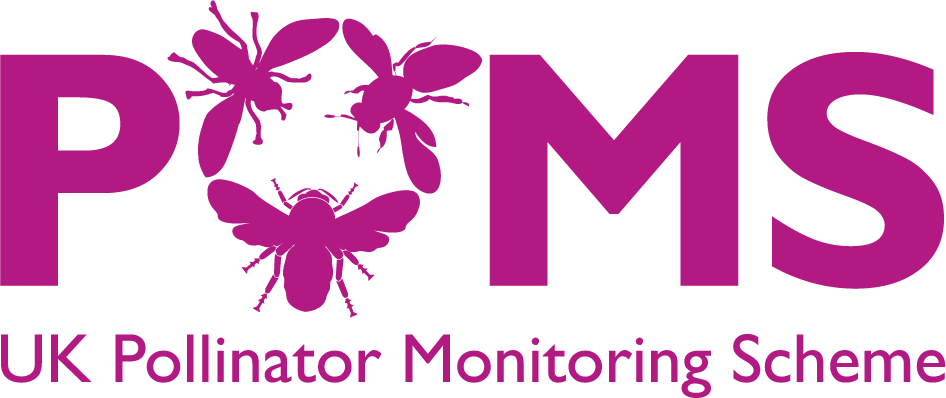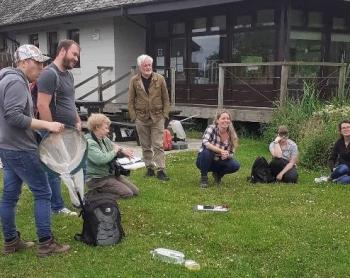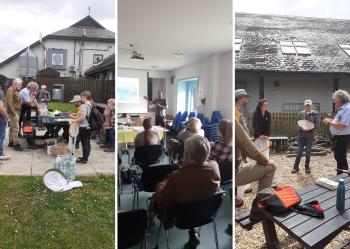PoMS takes off in Northern Ireland
Following a successful pilot project in 2021, this year Northern Ireland has implemented both PoMS, surveys, enabling us to achieve full UK coverage. During National Insect Week in June 2022, volunteers for the 20 new 1 km squares gathered together to learn more about how to carry out the surveys. In this blog, Pauline Campbell (DAERA) gives her account of the day.
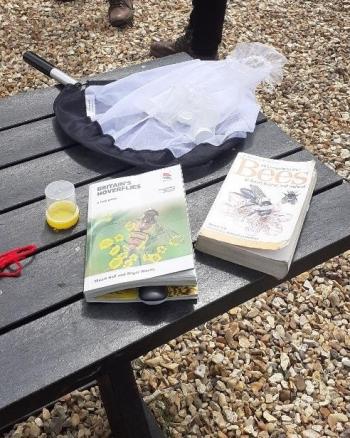
Volunteers 'got their eye in' looking at different species of bees and hoverflies - Pauline Campbell |
The sun was just breaking through the early morning cloud as I headed to Belfast International Airport. I knew the day had started quite a few hours earlier for the two intrepid PoMS supporters who were going to lead todays training session. The wonderful Richard Dawson was flying in from Manchester and Ryan Mitchell (aka ‘the fly guy’) was busing it over 100 miles from Sligo, to join us at Oxford Island Nature Reserve on the south shore of Lough Neagh. We stopped off at a local café for a hearty Ulster Fry, and to chat about how the day ahead might be structured, and what elements of PoMS to cover.
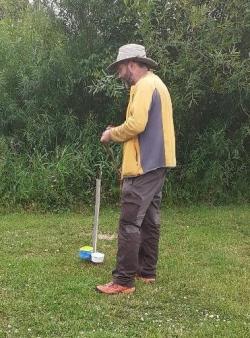
Richard Dawson (pictured) and Ryan Mitchell were there to help the volunteers with methodology and identification - Pauline Campbell |
The training day was targeted at volunteers who had kindly offered to ‘adopt’ one of the 20 1 km squares selected for PoMS monitoring in Northern Ireland. We had a lovely range of attendees; some Butterfly Conservation volunteers, Buglife Officers, a Local Biodiversity Officer, Mourne Heritage Trust volunteer, NIEA Scientific Officers, JNCC Science and Evidence Liaison Officer and a beekeeper with a keen interest in insects and conservation. Some had been introduced to PoMS 1 km Square Monitoring last year (2021) when they supported the initial pilot pan trapping surveys. But we all still had so much to learn from Richard and Ryan, and were grateful to have the opportunity to find out more about the scheme.
|
There was a fantastic range of attendees at the event - Pauline Campbell |
The morning was taken up working through the detailed methodology in the revised NI version of the PoMS 1 km Monitoring Guidance. We have made a few local changes, such as how we manage specimens, secure landowner access permissions, etc. We also spent some time on the FIT Count element of the survey; understanding differences in species groups, etc. By lunchtime we were keen to get outside and get familiar with the survey kit. We split into smaller groups and set up a few pan trap stations in the vicinity of the visitor centre, taking in Richard’s tips and advice, and checking we were correctly following instructions. Since the sun was now shining with temperatures of around 17°C (a tropical day in Northern Ireland!) we turned our attention to FIT Counts. With plenty of white and red clover, buttercups, selfheal, some bramble and birds-foot trefoil, there was a moderate range of bees and hoverflies using the area. Ryan kindly helped us identify a few of the more common species, and we ‘got our eye in’ looking at the different features of hoverflies and bees.
|
In groups, volunteers set up pan traps and completed FIT Counts - Pauline Campbell |
We then covered data entry and specimen management before the day drew to an end. Feedback was so positive, we really did learn a huge amount from the day’s activities. We couldn’t wait to get out to our 1km squares to start monitoring. What a great way to end National Insect Week!
It is so exciting to be able to bring PoMS to Northern Ireland, and contribute data to support our understanding of pollinator populations.
Huge thanks to Ryan, Richard and the UKCEH team for all the help and support.
